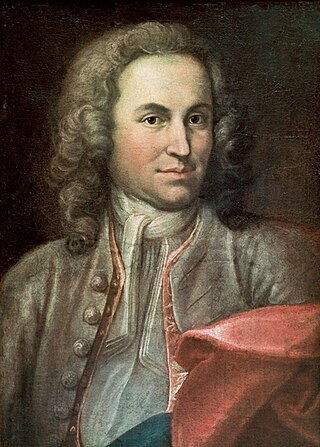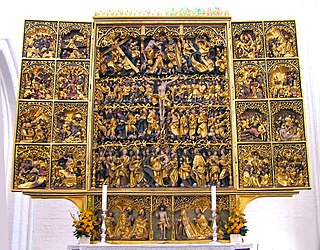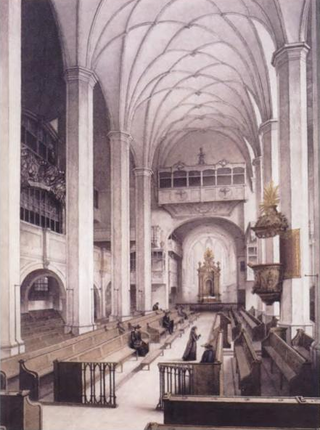Related Research Articles

Nach dir, Herr, verlanget mich, BWV 150, is an early church cantata by Johann Sebastian Bach composed for an unknown occasion. It is unique among Bach's cantatas in its sparse orchestration and in the independence and prominence of the chorus, which is featured in four out of seven movements. The text alternates verses from Psalm 25 and poetry by an unknown librettist. Bach scored the work for four vocal parts and a small Baroque instrumental ensemble of two violins, bassoon and basso continuo.
Marion Verbruggen is a Dutch recorder player and teacher.

Christ lag in Todes Banden, BWV 4, is a cantata for Easter by German composer Johann Sebastian Bach, one of his earliest church cantatas. It is agreed to be an early work partly for stylistic reasons and partly because there is evidence that it was probably written for a performance in 1707. Bach went on to complete many other works in the same genre, contributing complete cantata cycles for all occasions of the liturgical year. John Eliot Gardiner described it as Bach's "first-known attempt at painting narrative in music".
Bernard Krainis (1924-2000) was an American musician and co-founder of New York Pro Musica. He played recorder and studied with Erich Katz.

Johann Sebastian Bach was a German composer and musician of the late Baroque period. He is known for his prolific output across a variety of instruments and forms, including the orchestral Brandenburg Concertos; solo instrumental works such as the cello suites and sonatas and partitas for solo violin; keyboard works such as the Goldberg Variations and The Well-Tempered Clavier; organ works such as the Schubler Chorales and the Toccata and Fugue in D minor; and choral works such as the St Matthew Passion and the Mass in B minor. Since the 19th-century Bach Revival, he has been widely regarded as one of the greatest composers in the history of Western music.

The cantatas composed by Johann Sebastian Bach, known as Bach cantatas, are a body of work consisting of over 200 surviving independent works, and at least several dozen that are considered lost. As far as known, Bach's earliest cantatas date from 1707, the year he moved to Mühlhausen, although he may have begun composing them at his previous post in Arnstadt. Most of Bach's church cantatas date from his first years as Thomaskantor and director of church music in Leipzig, a position which he took up in 1723.

In Christian music, a Passion is a setting of the Passion of Christ. Liturgically, most Passions were intended to be performed as part of church services in the Holy Week.

Du wahrer Gott und Davids Sohn, BWV 23, is a church cantata by Johann Sebastian Bach. He composed it in Köthen between 1717 and 1723 for Quinquagesima Sunday and performed it as an audition piece for the position of Thomaskantor in Leipzig on 7 February 1723. The Sunday was the last occasion for music at church before the quiet time of Lent.

Johann Sebastian Bach composed the church cantata Brich dem Hungrigen dein Brot, BWV 39, in Leipzig and first performed on 23 June 1726, the first Sunday after Trinity that year. Three years earlier, on the first Sunday after Trinity in 1723, Bach had taken office as Thomaskantor and started his first cycle of cantatas for Sundays and Feast Days in the liturgical year. On the first Sunday after Trinity in 1724, he began his second cycle, consisting of chorale cantatas. The cantata Brich dem Hungrigen dein Brot is regarded as part of Bach's third cantata cycle which was written sporadically between 1725 and 1727.
Sir Jack Westrup, FBA was an English musicologist, writer, teacher and occasional conductor and composer.

Schauet doch und sehet, ob irgend ein Schmerz sei, BWV 46, is a church cantata by Johann Sebastian Bach. He composed it for the tenth Sunday after Trinity and it was first performed on 1 August 1723 in Leipzig.

Erschallet, ihr Lieder, erklinget, ihr Saiten!, BWV 172, is a church cantata by Johann Sebastian Bach, composed in Weimar for Pentecost Sunday in 1714. Bach led the first performance on 20 May 1714 in the Schlosskirche, the court chapel in the ducal Schloss. Erschallet, ihr Lieder is an early work in a genre to which he later contributed complete cantata cycles for all occasions of the liturgical year.

Johann Sebastian Bach composed the church cantata Komm, du süße Todesstunde, BWV 161, in Weimar for the 16th Sunday after Trinity, probably first performed on 27 September 1716.

Johann Sebastian Bach composed the church cantata Ach! ich sehe, itzt, da ich zur Hochzeit gehe, BWV 162, in Weimar for the 20th Sunday after Trinity and first performed it in 1715 or 1716.

Sie werden aus Saba alle kommen, BWV 65, is a church cantata by Johann Sebastian Bach. He composed it in 1724 in Leipzig for Epiphany and first performed it on 6 January 1724 as part of his first cantata cycle.

Himmelskönig, sei willkommen, BWV 182, is a church cantata by Johann Sebastian Bach. He composed it in Weimar for Palm Sunday, and first performed it on 25 March 1714, which was also the feast of the Annunciation that year.

Preise, Jerusalem, den Herrn, BWV 119, is a sacred cantata by Johann Sebastian Bach. He composed it in Leipzig for Ratswechsel, the inauguration of a new town council, and first performed it on 30 August 1723.

Johann Sebastian Bach composed the church cantata Schmücke dich, o liebe Seele, BWV 180, in Leipzig for the 20th Sunday after Trinity and first performed it on 22 October 1724.

Das neugeborne Kindelein, BWV 122, is a church cantata by Johann Sebastian Bach. Bach composed the chorale cantata in six movements in Leipzig for the Sunday after Christmas and first performed it on 31 December 1724. It is based on a 1597 hymn of the same name by Cyriakus Schneegaß. The work is part of Bach's chorale cantata cycle; in the format of this cycle, the text of the first and last stanzas of the hymn is retained unchanged while the text of the inner stanzas was paraphrased by an unknown librettist into a sequence of alternating arias and recitatives. The cantata is opened by a chorale fantasia and closed by a chorale setting. It is scored for four vocal soloists, a four-part choir, and a Baroque instrumental ensemble of recorders, oboes, strings and basso continuo.

Tritt auf die Glaubensbahn, BWV 152, is a church cantata by Johann Sebastian Bach. He composed this dialogue cantata in Weimar for the Sunday after Christmas and first performed it on 30 December 1714.
References
- 1 2 Bixler, Martha (2014). The American Recorder Society and Me...a memoir (PDF). p. 36.
- 1 2 3 "The Angelus: Our Newsletter, Volume 24, Number 15". The Church of Saint Mary the Virgin. 2022-03-06. Retrieved 2024-02-22.
- 1 2 "Up-Beat New York: Where to Sing and Play". New York Magazine. 5 (9): 37. February 28, 1972 – via Google Books.
- ↑ Bixler, Martha (2014). The American Recorder Society and Me...a memoir (PDF). p. 90.
- ↑ "Subject Heading "New York Recorder Guild Periodicals"". Research Catalog | NYPL. Retrieved 2024-02-22.
- ↑ "RILM Abstracts of Music Literature: Database Coverage List: Music Journals". www.rilm.org. Retrieved 2024-02-22.
- ↑ "Arts and Leisure Guide; Of Special Interest". The New York Times. Retrieved 2024-02-22.
- ↑ "Around Town". New York Magazine. 12 (20): 24. May 14, 1979 – via Google Books.
- ↑ "COPING; Three Into Two Did Go". The New York Times. Retrieved 2024-02-22.
- ↑ Jowett, Shannon (August 16, 2004). "New York Early Music Celebration". Vocal Area Network. Retrieved 2024-02-22.
- ↑ "New York Recorder Guild Inaugural Meeting, June 29, 2017". Deborah Booth. 2017. Retrieved 2024-02-22.
- ↑ "New York Recorder Guild Inaugural Play-in & Meeting - Gotham Early Music Scene, Inc". www.gemsny.org. 2017. Retrieved 2024-02-22.
- ↑ "New York Recorder Guild" (PDF). Recorder Society of Long Island Newsletter. 42 (7): 5. September 2019.
- ↑ "The Uptown Cantata Project". Bach in the Subways. 2022. Retrieved 2024-02-22.
- ↑ "BERA Concert Series" (PDF). Brookhaven Bulletin. 20 (16). Brookhaven National Laboratory Public Relations Office. April 20, 1973.
- ↑ Bixler, Martha (2014). The American Recorder Society and Me...a memoir (PDF). p. 176.
- ↑ Begley, Rachel (May 2015). "A Message from RSLI's Music Director" (PDF). The Recorder Society of Long Island Newsletter. 39 (3): 1.
- ↑ "Polyphony.com - Early Music Web Resources". www.polyphony.com. Archived from the original on 2016-11-14. Retrieved 2024-02-22.